Which is better? Ritz Crackers or Homemade Crackers... This article breaks down Ritz bits Cheese Crackers and tries to explain what each ingredient is and its potential impact on your body.
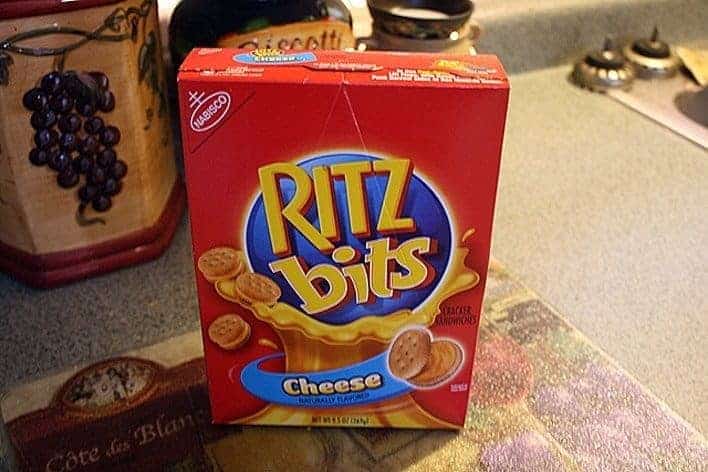
Contents
To help understand what we eat here in my house and begin to make a change, I decided to look at the labels on the foods we have in our pantry. Overall we don’t gorge on this stuff. We eat what would be considered a reasonably healthy diet by many standards, but I’m learning that health isn’t what it appears to be. We have some products in our pantry for those times when we might be on-the-go or just need something quick to satisfy the masses before dinner. Still, I’m learning that convenience is actually harming our bodies.
It is important to take a moment and evaluate the things we consume daily. I will analyze the ingredients of Ritz bits Cheese Cracker to see precisely what is in it.
Ritz bits cheese crackers
Ingredients Breakdown
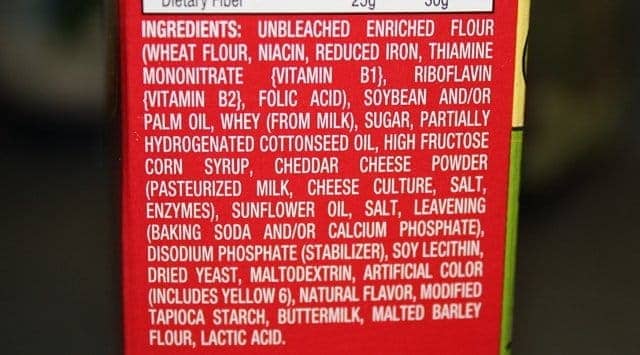
- Unbleached enriched flour (wheat flour, niacin, reduced iron, thiamine mononitrate – vitamin B1 & folic acid) - This doesn’t sound half bad, right? We know that bleached flour isn’t any good, but this is unbleached wheat flour with added vitamins. Good right? Well, the reason the flour is unbleached is that they remove the dark layers of the wheat (white flour comes from wheat, wheat flour is also widely used in other similar preparations.) to expose the lighter inner layer. They make the flour from the inner layer. The problem is the outer 2 layers of bran and germ contain the vitamins. So, the vitamins are put back in artificially.
- Soybean and/or palm oil - While not necessarily hydrogenated, therefore, not high in trans fats, both of these oils are high in fat types that are bad for our bodies.
- Whey - Whey is the by-product of making cheese and is very high in protein.
- Sugars - Added sugars are a culprit for weight gain in our diets. It causes an insulin response that triggers our fat storage to go into action. Too many sugars in food anyways are not recommended.
- Partially hydrogenated cottonseed oil - Contains trans-fats and is high in saturated fat. Trans-fats have been shown to significantly raise bad cholesterol levels. On top of that, it also lowers good cholesterol.
- High fructose corn syrup - We all know the controversy surrounding HFCS (high fructose corn syrup). Regardless of where you stand, it is still a processed sugar added to the product that causes your body to store fat. High fructose corn syrup may be a contributing factor for diabetes.
- Cheddar cheese powder - Some cheddar cheese powders can be made organic and naturally through a dehydration process. I have no idea how this powder was created.
- Sunflower oil - Sunflower oil is predominantly omega-6 rich, which can cause problems if not balanced with enough omega-3 in your diet.
- Salt - Sodium is a huge issue in our diets and should be avoided, but a small amount is ok. These crackers contain 160 mg of sodium per serving. The recommended maximum sodium intake from the FDA for an average healthy adult is 1500 mg per day. These crackers contain more than 1-tenth of your daily allowance in just 13 tiny crackers.
- Leavening - This is basically yeast; bread won’t rise without it. Even organic bread requires yeast, though I’m not exactly sure where it comes from and if you can get it in an organic variety. Still, I believe you can.
- Disodium phosphate - This is a preservative. It slows bacteria growth in foods but also acts as a leavening agent. Disodium phosphate can cause irritation to your respiratory tract and skin, and eyes.
- Soy lecithin - This is oil derived from soybeans, which are quite a controversial topic. Today, most of the soybean product is genetically modified, and soybeans themselves in their raw form are toxic. Soybean crops are also heavily covered in pesticides. Unless it says non-GMO (genetically modified organism) products, you should avoid soy products. This package does not specify.
- Dried yeast - Dried yeast is another relatively nonharmful ingredient that is used to make bread rise. Organic yeast would be void of pesticides; this product does not use organic yeast.
- Maltodextrin - Maltodextrin is essentially an artificial sweetener. Artificial sweeteners trick your body and confuse it. While nothing has been proven and most sweeteners remain “safe,” according to the FDA, we have no idea about their long-term effects on our bodies.
- Artificial color - Artificial colors are chemicals that make food a specific color or more vibrant in color. Many people have developed severe allergies to artificial colors.
- Natural flavor - Natural flavor isn’t really as good as it sounds. It’s not like they take a specific natural product – say an orange – and add the juice. If they did that, it would say that. Natural flavors are still created in a lab using natural chemicals. Still, they could be a combination of many things to achieve the taste they are looking for.
- Modified tapioca starch - This is a thickening agent that turns into a gel and is used in many things, from these crackers to plywood and batteries. It has many more non-food applications than food applications. I could not find any real information about it being unsafe. It is still derived from corn, tapioca, rice, wheat, or any number of other grains or starches.
- Buttermilk - Buttermilk is the liquid milk that remains after churning butter. As with most dairy products, when it is not labeled organic you risk the chances of it containing hormones, antibiotics, and other additives that don’t “do a body good”.
- Malted barley flour - Barley is actually a very healthy whole grain. Malted barley flour is barley that has been dried and ground into flour.
- Lactic acid - I haven’t found conclusive information about lactic acid. It is supposedly good for your muscles and is basically a good bacteria that keeps the bad bacteria from forming. In this case, it is used as a preservative, but I’m not sure how it is created. In our bodies, it is created to help our muscles produce it to obtain energy. Overall the information I found showed this to be a natural process and a better preservative than most of them.
Why are there so many ingredients?
The answer is simple, it makes commercial sense. You have to serve what your customers need. The reason you love these crackers so much is their taste. Let's be honest here, no one would eat them for health reasons. It's the taste that gets us hooked. To get that perfect taste coupled with a shelf like that makes sense- a whole gamut of chemical-based ingredients are used. That's why it's called processed food, or in this case, we can safely call it over-processed food.
There are so many ingredients in the Ritz Crakers because:
- It enhances shelf life.
- Preserves nutrition or whatever nutritional value remains
- Keeps price of the product under check
- Makes food product safer to consume
To achieve the objectives mentioned above, there is some college-level chemistry involved. Pun intended! Although using so many artificial preservatives looks like overkill, trust me, the crackers brand tries their best to keep them the bare minimum. Nevertheless, it's still over-processed and something that's not healthy for us to consume. Fret not! You can cook healthy options for yourself: the same great taste minus the health hazards. Once you get the hang of these homemade beauties, I am sure you would not buy crackers from the market ever again. They are going to be better than Ritz any day.
Are Ritz Crackers vegan?
Yes, Ritz Crackers are vegan. They do not have any ingredient that is animal-sourced. This stands true if you don't consider yeast and bacterias as animal-derived products.
Ingredients that other crackers have?
Other over-processed and harmful ingredients you'd typically see in crackers include:
- High Fructose Corn Syrup: Yes, we know Ritz has it, but this is something that no commercial cracker brand can do without. High fructose corn syrup comes in many grades; you actually have to dig in a lot to find the quality of high fructose corn syrup. Taking in more than that recommended amount per serving can harm your health.
- Wheat Flour: Again, a common ingredient, wheat flour, just cannot be ignored while making crackers. The wheat flour used here is the unbleached variety, which is not healthy. Wheat flour is also a source of gluten. In fact, wheat flour is one of the first food items that was associated with it.
- Corn syrup, soy lecithin: Might come as a surprise, but corn syrup, soy lecithin, is one the most commonly used ingredients in the manufacturing of crackers. It's not only the crackers but also many other snacks that contain a fair amount of corn syrup - soy lecithin. Are they bad? Yes, they are. Corn syrup-soy lecithin has been associated with type 2 diabetes and fertility issues likewise. So, I would recommend that you stay away from corn syrup-soy lecithin enriched products. Read the labels - If it says corn syrup-soy lecithin, then stay away from it.
- Salt Leavening: Using salt as a salt leavening agent is not an oxymoron; salt and salt leavening are two different things. Salt leavening is the process of adding salt while baking to stabilize the yeast formation. Without using salt leavening agents, your crackers would not feel right and crisp. Although its quantity might add some extra salt to that recommended amount per serving.
- Barley: Barley may be used either as lecithin malted barley flour or malted barley flour natural. Technically both of them are similar; however, there are some differences. Lecithin malted barley flour is basically liquid in nature and used as a baking media. Mark the word lecithin in lecithin malted barley flour, get the picture for liquefying the flour lecithin is used. On the other hand, malted barley flour, natural as the name suggests, is your plain barley flour just into malting. Which one is better? Malted barley flour natural or lecithin malted barley flour? Obviously, malted barley flour natural is a better choice; however, it does not give that much flavor flexibility; hence is seldom used.
- Cotton Seed Oil: The cottonseed oil used in baking is in vague terms called sugar partially hydrogenated cottonseed oil. Yes, sugar partially hydrogenated cottonseed oil is bad for health. It's just because it is cheap, that's why it is used widely. However, if you read either individually or in combination, the word sugar partially hydrogenated cottonseed on the label. Please keep the pack back on the shelf. Sugar partially hydrogenated cottonseed oil can lead to severe health conditions and should be avoided. If something has more than the required amounts of sugar, Mark the word sugar, stay away from it.
How to make homemade crackers
Here are the two amazing recipes that I have tried and tested myself. They are preservative-free and contain ingredients that are sourced ethically. I used the term ethically here to emphasize the importance of including top quality & healthy ingredients. After all, it's I, along with my loved ones, who are going to consume these great-tasting crackers.
The best part about making these crackers at home is that you can be flexible with your approach. If you observe the list of ingredients carefully, that am sure you would. You would see that there are many optional ingredients that you can add to make things more savory. There could be many more flavor variations that you can indulge in. Just use your palate logic for that. I would mention here- Since no preservatives or artificial ingredients are being added, the shelf life of these crackers would be less compared to those you buy from the market. So, just make the quantity that you and your family can consume within a week. Although if stored well, they could last over a week as they say, "Better Safe Than Sorry."
Some Storage Tips
- Do not store crackers while they are still hot.
- Allow them to cool to room temperature.
- Use a clean - airtight container to store them.
- Store them in a cool, dry place.
- Consume them within a week.
It's vital to follow the storage tips for getting the maximum fun out of your homemade crackers. I have also mentioned the recipe specific storage instructions in the Keto Cracker recipe mentioned just below. Please adhere to them; you don't want limp, soggy crackers to destroy the mood. Also, do some math on the quantity that you would consume every week. There is no point in being wasteful with food. Rest assured, these crackers will make you drool, and you'll always want more.
Keto Cracker Recipe
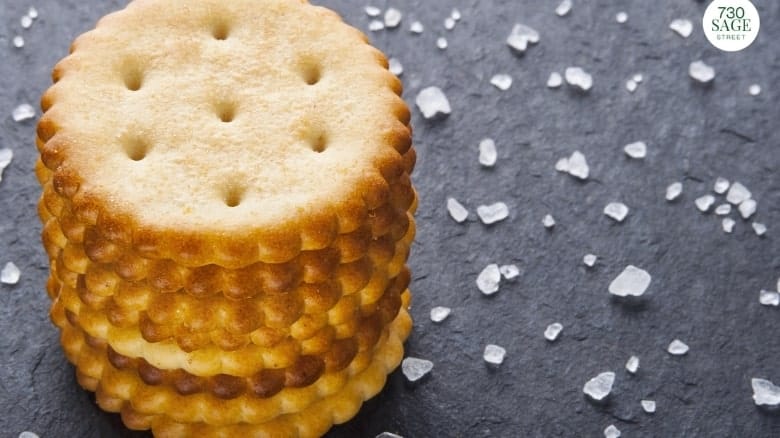
Servings Per Container: 50 approx
Ingredients
- 8 tablespoon salted butter softened (not melted)
- 2 egg whites
- 2 ¼ cups Almond Flour
- Salt to taste
- Optional - Italian Seasoning, Cheese, Rosemary, or any other herb combination
Instructions
- Preheat oven to 350°F or 177°C
- In a large bowl, combine the butter and almond flour using an electric hand mixer on low-medium speed. Play with the flavor profile by adding 1 teaspoon of Italian Seasoning.
- Add the egg whites and a pinch of salt. Continue mixing on low speed, until the mixture is uniform, and forms a smooth dough.
- Roll the dough from the center until it reaches ⅛ inch in thickness.
- Using a small knife or a pizza cutter to cut the dough into approximately 1 ½ inch squares. Sprinkle the dough with salt.
- Bake for 10-15 minutes or until crackers have turned a light brown. Then carefully remove from oven and allow to cool.
- Enjoy immediately or transfer to a lidded container and store at room temp for up to a week. Storing in the refrigerator will prolong life, but it can also cause the crackers to lose some of their crunch.
- Servings per container depend upon the size of the container that you are using. You can always calibrate the amount per serving as per your requirements.
📋 Recipe
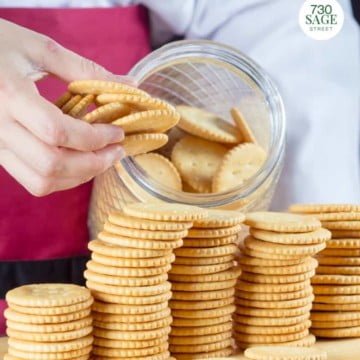
Keto Crackers
Ingredients
- 8 tablespoon salted butter - softened
- 2 egg whites
- 2.25 cups almond flour
Instructions
- Preheat oven to 350°F or 177°C
- In a large bowl, combine the butter and almond flour using an electric hand mixer on low-medium speed. Play with the flavor profile by adding 1 teaspoon of Italian Seasoning.
- Add the egg whites and a pinch of salt. Continue mixing on low speed, until the mixture is uniform, and forms a smooth dough.
- Roll the dough from the center until it reaches ⅛ inch in thickness.
- Using a small knife or a pizza cutter to cut the dough into approximately 1 ½ inch squares. Sprinkle the dough with salt.
- Bake for 10-15 minutes or until crackers have turned a light brown. Then carefully remove from oven and allow to cool.
- Enjoy immediately or transfer to a lidded container and store at room temp for up to a week. Storing in the refrigerator will prolong life, but it can also cause the crackers to lose some of their crunch.
- Servings per container depend upon the size of the container that you are using. You can always calibrate the amount per serving as per your requirements.
Notes
Nutrition
Homemade Cracker Recipe
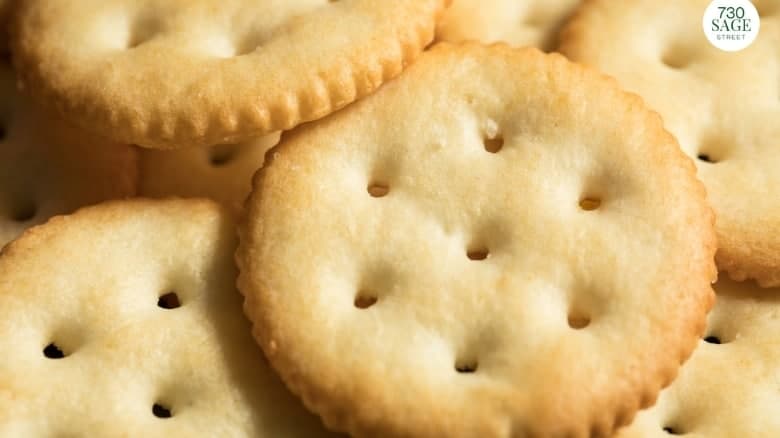
Servings Per Container: 50 approx
Ingredients
- 1 ¼ cups flour whole wheat, fresh ground, or all-purpose
- ½ - 1 teaspoon of Italian Season or your favorite herb
- ½ teaspoon salt
- 4 Tablespoons butter
- ¼ cup water
- 1 Tablespoon honey
Instructions
- Preheat oven to 400°F or 204°C
- Measure out dry ingredients into a large mixing bowl.
- Cut in butter until it looks like pea-sized clumps.
- Add in water and honey, stir until just combined.
- Lightly flour a baking sheet or stone. Roll dough out on it. Use a pizza cutter and cut into desired shapes. Sprinkle with sea salt.
- Bake for 10 minutes!
- Servings per container will depend upon the cracker size and that of the container.
📋 Recipe

Homemade Cracker Recipe
Ingredients
- 1 ¼ cups flour
- 1 teaspoon Italian seasoning - or your favorite seasoning
- 4 tablespoon butter
- ¼ cup water
- 1 tablespoon honey
Instructions
- Preheat oven to 400°F or 204°C
- Measure out dry ingredients into a large mixing bowl
- Cut in butter until it looks like pea-sized clumps
- Add in water and honey, stir until combined
- Lightly flour a baking sheet or stone. Roll dough out on it. Use a pizza cutter and cut into desired shapes. Sprinkle with sea salt.
- Bake for 10 minutes.

Kena
Hey! This looks fun. What type of grains do you use? Also how thick do you roll out your dough?